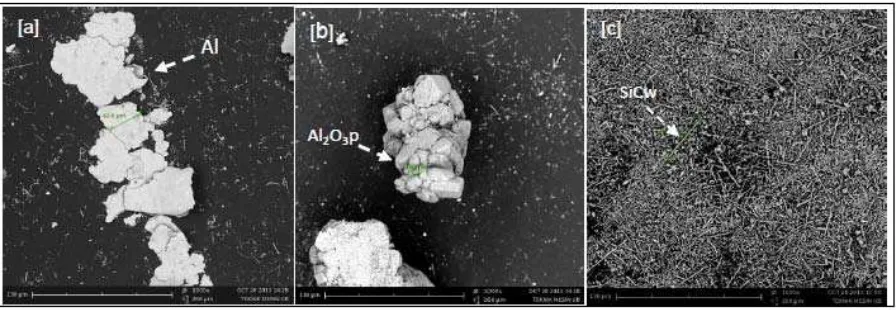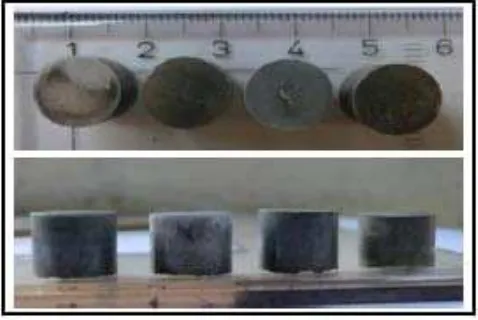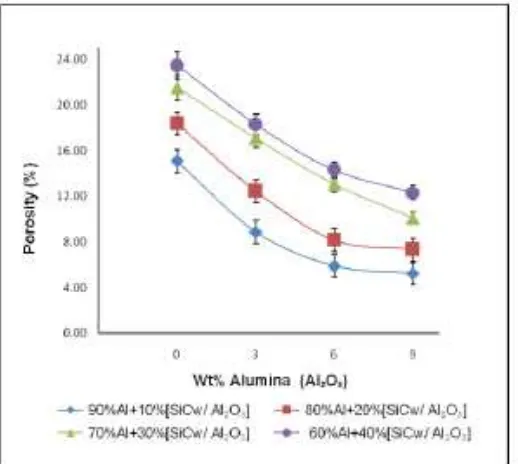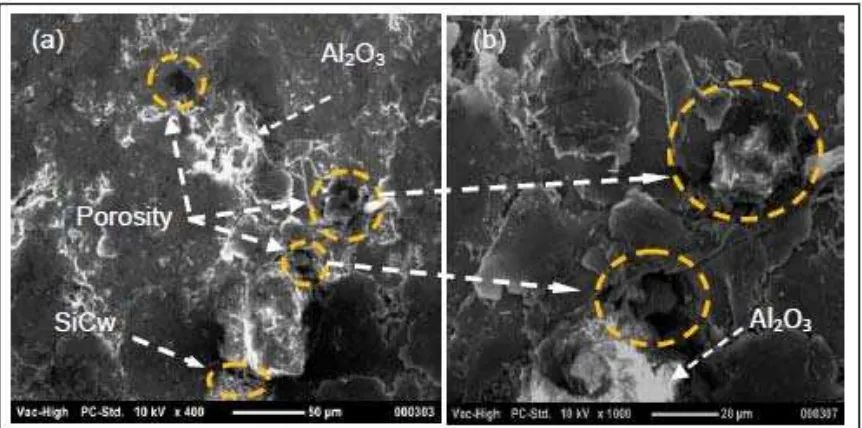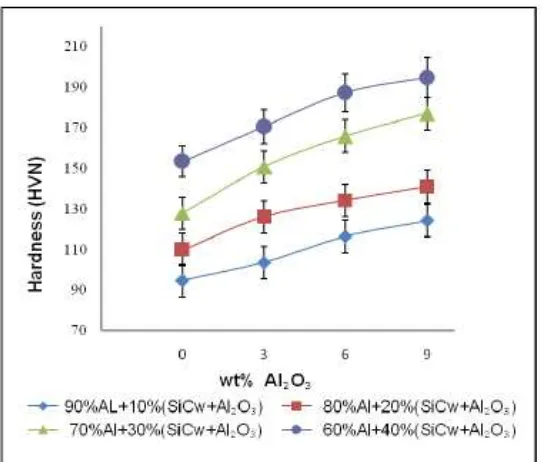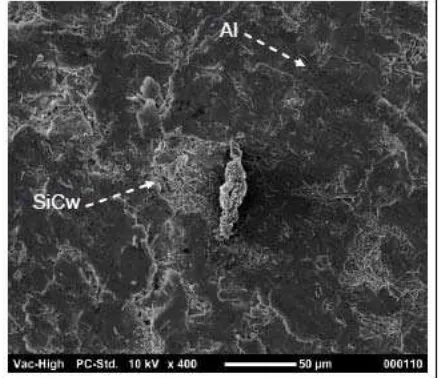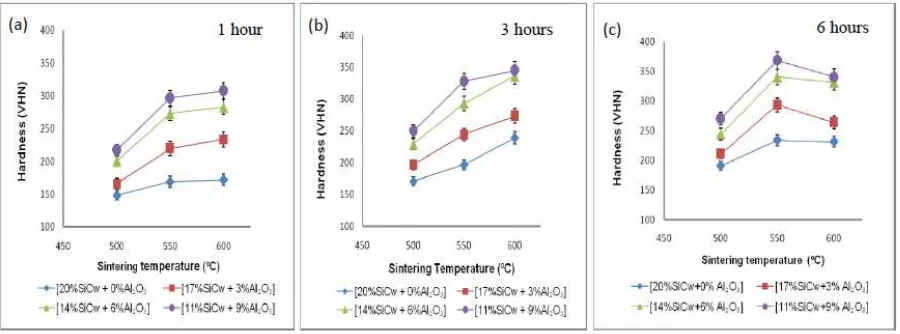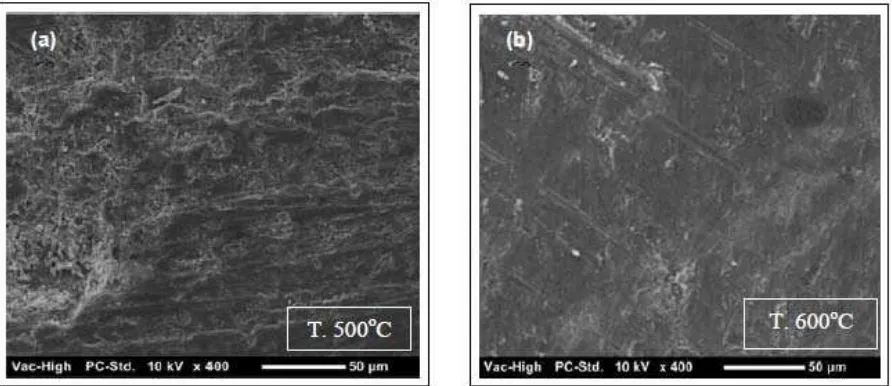AENSI Journals
Australian Journal of Basic and Applied Sciences
Journal home page
Corresponding Author: Ketut Suarsana, Mechanical Engineering Department, Brawijaya University, East Java, Malang, Indonesia. Jl. Veteran Malang, Phone (0341) 895287
The Effect Composition of Reinforcement SiC Whiskers and Al2O3 Particulates on
Characteristics of Aluminum Matrix Composite
1,2Ketut Suarsana, 1Rudy Soenoko, 1Agus Suprapto, 1Anindito Purnowidodo
1Mechanical Engineering Department, Brawijaya University, East Java, Malang, Indonesia. Jl. Veteran Malang, Phone (0341) 895287 2Mechanical Engineering Department, Udayana University, Denpasar, Bali, Indonesia.
A R T I C L E I N F O A B S T R A C T
In the present investigation fine aluminum powder was selected as the matrix, and Carbon Silicon whiskers (SiCw) together with Alumina particles (Al2O3p) were used as reinforcement. The composite was formed under 25 kN pressure over 15 minutes holding time for each specimen. The characteristics tests included those for density, porosity, hardness and SEM. The results showed that the addition of the combined SiCw and Al2O3p reinforcements resulted in a decrease in density and an increase in porosity. However, it was the addition of the Al2O3p reinforcement itself which gave rise to the increase in hardness. The main cause of this was that the Al2O3 particles were smaller than those the aluminum matrix so could spread easily through it giving a good bond. While the SiCw in the form of fibres contributed to making it more porous. In this case the addition of Al2O3p itself had an effect on composite hardness. In the sintering process, extending holding time caused the highest increase in hardness at temperatures of 550oC with a holding time of 6 hours.
© 2013 AENSI Publisher All rights reserved. To Cite This Article: Ketut Suarsana, Rudy Soenoko, Agus Suprapto, Anindito Purnowidodo., The Effect Composition of Reinforcement SiC Whiskers and Al2O3 Particulates on Characteristics of Aluminum Matrix Composite. Aust. J. Basic & Appl. Sci., 7(14): 246-256, 2013
INTRODUCTION
Components based on matrix Aluminum with Silicon Carbon whisker (SiCw) reinforcement, called Aluminum Matrix Composite (AMCw), have been developed widely due to its lightweight, strength, thermal and electrical conductivity as well as high corrosion resistance characteristics (Gibson, Ronald F., 1994). Essentially, the SiCw reinforcement prevents catastrophic brittle failure by dissipating energy. Toughening mechanisms, such as crack deflection, whisker pullout and whisker bridging, depend to a large extent on the nature of the whisker-matrix interface (Garnier, V., et al., 2004). Also, strength deflection influenced by the percentage by weight of the reinforcement SiC with or without heat treatment or the effects of various silicon carbide and aging time on the alloy hardness value. However, the longer the aging time, the lower the hardness value (Kalkanli, A., & S. Yilmaz, 2007; Bolaji, S., & V. Sunday, 2006). The effects of carbide particles coated and non-coated silicon on the mechanical properties of aluminum-based metal-matrix composites with silicon on the mechanical properties of the aluminum-based metal-matrix composites show that it improves bonding between the matrix and reinforcement but that without the silicon coating there is deformation and a dimpled fracture surface (Lim, D., et al., 2001; Davidson, A., 2000). The strength and wear resistance of alumina-silicate monolithic carbon increases with the addition of silicon metal or ferrosilicon and this additive is more effective than either carbon black or sulfur (Lim, D., et al., 2001; Karamian, E., & A. Monshi, 2009). The highest density and lowest porosity of Al/SiC-Al/Al2O3 isotropic composite laminate is obtained at 40% volume fraction and the lowest shrinkage is achieved in 30% volume fraction (Widyastuti, Dedi Priadi., 2008). Hot deformation behavior of the composite shows that the addition of SiCw increases the flow stress a high temperature, yet, it decreases failure strain (Jean, J.-sic, & Leeb, H.-in. 1997). Hot deformation characteristics of the composite AA.2124 with silicon carbide whiskers and 15% SiCw+SiCp reinforcement show that composite flow stress increases with an increasing percentage of SiCw. In addition, SiCw is more effective in increasing strength than SiCp (Jean, J.-sic, & Leeb, H.-in. 1997; Ko, B.-chul, & Yoo, Y.-chul, 1996). The mechanical properties of Al-based powder metallurgy composite alloys 2014 and 6061 reinforced with SiC particles or fibers show a high elastic modulus, high tensile strength and low elongation percentages (Srinivasa, C., 1996; Khorramdel, Parshang., Behfuruz, Mohamad Reza, 2013).
properties of the Al-Mg-Si composite matrix alloy reinforced with Al2O3w, processed by powder metallurgical techniques, have high mechanical properties at room temperature (Corrochano, J., et al., 2008). High oxygen surface content appears to affect the whisker-matrix interfacial bonding thus decreasing the amount of crack deflection, whisker pullout and whisker bridging are required to reach high fracture toughness values. In addition, the SiCw surface chemistry has a major impact on the fracture toughness when used as reinforcement in Al2O3 matrix composites. The high fracture toughness is associated with the presence of carbon excess on the surfaces, while the low fracture toughness is attributed to oxygen excess (Garnier, V., et al., 2004; Homeny, J., et al., 1990).
In previous researches (Garnier, V., et al., 2004; Froyen, L., B. Verlinden, 1994; Corrochano, J., 2008) the metal matrix composite (MMC) based on the Al matrix were reinforced by SiCw or Al2O3 particulate. However, the effect of SiC whiskers together with Al2O3 particulate reinforcement in various weight by
percentages on metal matrix composite (MMC) have not been investigated yet. In this research, the effect of the combined SiCw and Al2O3p reinforcement on composite characteristics and mechanical properties, especially of density, porosity and hardness were investigated.
MATERIALS AND METHODS
In this research, fine aluminum powder was selected for the matrix with a purity above 90%, density ρ = 2.7 gm/cm3, hardness 75 - 95 Hv, and a grain size of 32 to 45 μm. The reinforcement were commercial SiCw fibres with diameter of d = 0.45 to 0.65 μm, length l = 5 to 80 μm, density ρ = 3.2 gm/cm3, hardness = 2400 Hv and Al2O3 particulates with a density of ρ = 3.8 gm/cm3, a grain size of 1 to 5 μm and hardness = 1800 Hv. In addition, a solution of 96% ethanol (CH3COOH) was used as a mixer medium. Figure 1 shows Scanning electron microscope (SEM) photos of each raw material composite.
Fig. 1: Scanning electron microscope (SEM) raw material photos [a] Fine aluminum powder [b] Al2O3
particles [c] SiC whisker fibers.
The composition of weight by percentages of the composite matrix and reinforcement is shown in Table 1. The mixing process of composite was carried out by mixing SiCw with Al2O3p in a wet mixing process with 5 ml ethanol as the medium. The percentages by weight (wt%) of the Al2O3p were : 3 wt%, 6 wt% and 9 wt%
respectively. At this stage, weighing powders of Al and (SiCw+ Al2O3p) according to the weight of each
fraction. The proportion by volume between the Al+(SiCw+ Al2O3p) and the ethanol was 1:2. The stirring was
done by a magnetic stirrer at 50°C in a glass beaker until all the ethanol had evaporated and the mixing process was complete. The mixing process took 30 minutes. After the mixing process was finished, the mixed material was dried in an oven at 200oC until completely dry.
Table 1: Percentage by mass of Aluminum matrix and SiCw+Al2O3p reinforcement Al Fine
avoid adherence of composite to its wall. The lubricant was 1% weight of total composite material. The specimen material was then placed in the mould and hydraulic pressure of 25 kN exerted on it for 15 minutes to obtain strength and uniform pressure. Specimens are made in the cylindrical form in volume of ± 0.5 cm3, diameters of 0.8 cm and heights of 1 cm. Specimen density, porosity and hardness was calculated by weight percent. Figure 2. Shows the specimen results of a hydraulic press.
Fig. 2: Specimen compaction results
The test for determination of composite characteristic followed ASTM C373-88 standards. The Density,
„B‟, (gm/cm3) was the ratio between mass, „D‟, (gm) and exterior volume, „V‟, (cm3). The Composite density
was calculated by the following equation (ASTM., 2003):
The apparent porosity, „P‟, expressed as a percentage of the relationship of the volume of the specimen open pores to its exterior volume. In the following calculations, the assumption was made that 1 cm3 of water weighs 1 gm. Apparent porosity was calculated as follows:
(1)
The apparent porosity, „P‟, expressed as a percentage of the relationship of the volume of the specimen openpores to its exterior volume. In the following calculations, the assumption was made that 1 cm3 of water weighs 1gm. Apparent porosity was calculated as follows:
P%=[(M-D)/V] x100 (2)
Where: Exterior volume, „V‟, was determined by reducing saturated mass from suspended mass. V, cm3 = M – S. Dry mass, „D‟, was obtained by drying the test specimen to aconstant mass by heating them in an oven. Suspended mass, „S‟ measurement were found by hanging the spesimens on the arm of a pair of scales using a wire hanger calibrated to zero. The length of the wire was the same steady for all specimens. Saturated mass, „M‟, was obtained by weighing the specimen after wiping with a damp cloth to remove water droplets and then rolling them a wet cloth.
Hardness was measured by a Vickers test, with based on ASTM (E 92–82, 2003) standards. The microstructure observation was conducted on the specimen under the Scanning electron microscope (SEM) to find the composite material interface microstructure. The sintering process was then performed to determine the mechanical properties of the composite under treatment temperatures and holding times. The sintering temperature of 500°C, 550°C and 600°C with a holding time of each 1 hour, 3 hours and 6 hours.
RESULTS AND DISCUSSION
Density and Porosity:
Figure 3, shows the relationship of density to composite composition. Although the Al2O3p alone increased
the density of the composite, it can be seen that increasing the SiCw+Al2O3p reinforcement in the Aluminum matrix, decreased composite density. The decrease in density may have been related to the porosity formed in the composite, see Fig. 4, in which the reinforcement increased the percentage of the porosity in every weight percentage of the Al2O3p. Fig. 5a shows the porosity of the composite with 60% Aluminum matrix and 40%
reinforcement in which the SiCw and Al2O3p were 40 wt% and 0 wt%, respectively. The arrows point to areas
of porosity, and under higher magnification, see Fig. 5b, indicate that these areas are rich in SiCw thus it is clear D
that the porosity here was contributed by the SiCw. The porosity was reduced when the reinforcement was 10%, consisting of the 9 wt% Al2O3p and 1 wt% SiCw (Fig. 6a). The arrows point to those porous parts and regions rich in Al2O3p. Fig. 6b shows these sections in higher magnification and their porosity can clearly be seen. The
decrease in porosity was caused by the Al2O3 which was in particulate powder form, whereas, the SiCw was in fibre form. In addition, the Al2O3 particles were smaller than the matrix ones and may have inserted themselves easily into the cavities between the matrix particles, while SiCw, in the form of single fibre, extended easily to form pores, so that the higher the Al2O3p levels, the lower porosity. So, more Al2O3p will reduce the formation
of pores. In the previous research (Widyastuti, Eddy, S., Siradj, 2008), found that the higher the percentage of reinforcement, the higher the density of the composite became but the lower the porosity. The test results showed increased density caused by Al2O3p articles with small grains and hard, as well as the porosity reduction
due to increased fibre SiCw.
Fig. 3: The effect of composition weight SiCw+Al2O3p reinforcement in the aluminum matrix on density
(gm/cm3)
Fig. 5: SEM Microstructure surface (a) 400x and (b) 1000x containing 40% of (40wt% SiCw+0wt% Al2O3p)
reinforcement in the aluminum matrix 60 wt%.
Fig. 6: SEM Microstructure surface (a) 400x and (b) 1000x containing 10% of (9wt% Al2O3p + 1wt% SiCw)
reinforcement in the aluminum matrix 90wt%.
Hardness:
The effects of composition weight percentage of the composite on hardness:
Figure 7 shows the relationship between hardness and composite composition. It can be seen that any increase in the composition of the combined reinforcements SiCw and Al2O3p to the Aluminum matrix
composition, induced a corresponding increase in hardness. This finding is similar to that of previous research (Garnier, V., et al., 2004; Widyastuti, Eddy, S., Siradj, 2008), namely, that the greater the amount of reinforcement composition used, the higher the hardness value obtained from increased bonding. Similarly, for each reinforcement to the composition, the increase in the weight percentage of the Al2O3p reinforcement lead to increased hardness. This came about because the Al2O3p articles were smaller than those of the aluminum
matrix itself, enabling them to spread through it evenly. The Al2O3 particle itself has a high hardness value of the aluminum matrix, causing increased hardness. Furthermore, any reduction in SiCw to the combined SiCw+ Al2O3p reinforcement, also lead to an increase in hardness. This could have been due to random the SiCw fibres
were able to increase the number of pores. Generally, any addition of reinforcement to aluminum matrix causes a corresponding increase in hardness. In this case, the effect of the addition of the Al2O3p itself had an impact on
composite hardness.
Fig. 7: The effect of composition reinforcement SiCw+Al2O3p in the aluminum matrix on hardness
Figure 8 is shows the composition of the composite with 60% aluminum and 40% reinforcement where SiCw and Al2O3p were 31% and 9%, respectively and that the percentage by weight of the SiCw was greater
than that of the Al2O3p. Fig. 8 shows the areas with high levels of the SiCw and Al2O3p. Reducing
reinforcement composition to 10% of 4 wt% SiCw and 6 wt% Al2O3p, as shown in Figure 9, areas poor in SiCw
and clearly visible SiCw fibres with Al2O3p articles. Hardness values increased in areas rich in the combined
reinforcements SiCw and Al2O3p compared to regions being poorer in reinforcements. This was due to the high hardness value of SiCw and Al2O3p reinforcement on aluminum matrix.
Composite hardness values for the 0 wt% Al2O3p reinforcement treatment to the composition of 90 wt% Al +10 wt% SiCw, 80 wt% Al + 20 wt% SiCw, 70 wt% Al + 30 wt% SiCw and 60 wt% Al + 40 wt% SiCw were : 94.612 VHN, 109.810 VHN, 127.892 VHN, and 153.275 VHN respectively. When SiCw itself was increased without Al2O3p in the aluminum matrix, hardness rose because the long SiCw fibres, their small size, smaller than the fine aluminum matrix powder and the reduction in pore size and their even distribution. It also occurred due to the decrease in weight percentage of the aluminum matrix composites. One of the properties of aluminum was its ductibility and low hardness. The microstructure of the composite surface is shown in the SEM photographs in figures 10 and 11. On the other hand, the composite hardness value increased with the addition by weight percentage of the combined reinforcements. So, hardness values rose with Al2O3p reinforcements of 3%, 6% and 9% to aluminum matrix composites (60% Al), namely, 170.539 VHN, 187.360 VHN and 194.747 VHN respectively. Hardness increased due to the Al2O3p itself, its small particles inserted themselves easily and spread evenly through the aluminum matrix.
The results showed that the higher percentages in the combined weight of the SiCw and Al2O3p
reinforcements in the aluminum matrix increased hardness values. Strengthening the composition affects its mechanical properties as evidenced by the increased value in the composite hardness.
The Influence of Sintering Temperature and Holding Time on Composite Hardness:
Figures 12 (a), (b) and (c) indicate the relationship between hardness levels and sintering temperature on the A1+(SiCw+ Al2O3p) composite at holding times of 1, 3 and 6 hours respectively. Furthermore, the graphs 12(a)
and (b) show that raising both sintering temperature and holding time of the aluminum matrix composite combined with SiCw + Al2O3p) reinforcement, leads to increased hardness values. On the other hand, at 600ºC
ductability. The longer the holding time of the sintering process for each A1+(SiCw+ Al2O3p) composite for
each treatment, the lower their hardness values.
Fig. 8: SEM Microstructure surface 40% of 31wt%SiCw+9%wtAl2O3p reinforcement in aluminum matrix
composite of 60 wt%, (rich in SiCw+Al2O3p)
Fig. 9: SEM Microstructure surface 10% of 1wt%SiCw+9wt%Al2O3p reinforcement in aluminum matrix
composite of 90 wt%, (poor in SiCw+Al2O3p)
Fig. 10: SEM Microstructure surface 20% of 20wt% SiCw + 0wt% Al2O3p reinforcement in aluminum matrix
Fig. 11: SEM Microstructure surface 10% of 10wt% SiCw + 0wt% Al2O3p reinforcement in aluminum matrix
composite of 90 wt%.
The influence of sintering temperature and holding time on composite hardness:
Figures 12 (a), (b) and (c) indicate the relationship between hardness levels and sintering temperature on the A1+(SiCw+ Al2O3p) composite at holding times of 1, 3 and 6 hours respectively. Furthermore, the graphs 12(a)
and (b) show that raising both sintering temperature and holding time of the aluminum matrix composite combined with SiCw + A12O3p) reinforcement, leads to increased hardness values. On the other hand, at 600ºC
and a holding time of 6 hours, composite hardness decreased. This occurred as the sintering temperature neared the melting point of the aluminum in the matrix composite, namely, 660ºC. The hardness decreased because of changes in the aluminum matrix structure and the intrinsic properties of aluminum itself of low hardness of ductability. The longer the holding time of the sintering process for each A1+(SiCw+ Al2O3p) composite for
each treatment, the lower their hardness values.
Fig. 12: The graph of the relationship between sintering temperature and the Al+(SiCw + Al2O3p) hardness. (a)
1 hour holding time (b) 3 hours holding time (c) 6 hours holding time
For the 80% A1 + (11% S1Cw + 9% A12O3p) composite at sintering temperatures of 500ºC, 550ºC and
600ºC, the hardness values were : 244.275 VHN, 340.404 VHN and 331.783 VHN respectively. The SEM photograph in fig. 13 (a) shows the results of the sintering process at 500ºC for the above composite, the structure of the composite surfaces and the reinforcement is not homogenous and there is some porosity. Figures 13 (b) demonstrates a lower porosity and the composite structure is nearly homogenous. This was influenced by the sintering temperature approaching the melting point of aluminum, also, the bonding between the matrix surface and the reinforcement can clearly be seen to be homogenous.
Whereas, for the composite with 80% A1+(11% SiCw+9% Al2O3p) and sintering holding times of 1 hour, 3
respectively. Figs. 14(a) and (b) show SEM photographs after 1 hour and 6 hours of sintering, demonstrating the more homogenous structure of the composite after the 6-hour sintering process. The relatively long 6-hour sintering process at 600ºC also lowered porosity in all the different composite treatments. The results indicate that both temperature and holding time have a significant effect on hardness, whereas, at higher temperatures and extended holding times hardness decreases. In addition, the sintering process increases density by improving composite homogeneity, and by lowering the amount of pores as well as oxygen trapped in its structure.
Fig. 13: SEM photos of the aluminum matrix with 11%SiCw+9% Al2O3p reinforcement (a) at 500oC with 6
hours and (b) at 600oC with 6 hours.
Fig. 14: SEM photo of the aluminum matrix with 11% SiCw +9% Al2O3p reinforcement after (a) 1 hour
sintering with 500oC and (b) 6 hours sintering with 500oC.
Conclusion:
1. The density of the Al+(SiCw + Al2O3p) composite was influenced by the composition of the weight by
percentage (wt%) of the reinforcement. The lower the weight percentage of the combined SiCw+ Al2O3p
reinforcements in the aluminum matrix composites, the higher their density. However, the addition of the SiCw fibres effectively reduced density. The highest density obtained was that from the 90% Al+ 10% (SiCw + Al2O3p), namely, 2,288 gm/cm3.
2. On other hand, the lower the weight percentage (wt%) of the reinforcements, the lower the composite porosity. This was caused by the decreased amount SiCw and increased of Al2O3p to the composition, reduced the number of pores. The lowest porosity (5.235%) was obtained with the same composition that had the highest density.
3. The higher weight percentages (wt%) of the composite reinforcement was proportional to composite hardness. The higher the weight percentage, the higher hardness obtained. This was due to the combined reinforcement of both SiCw and Al2O3p which have higher hardness values than the aluminum matrix. The
highest hardness, namely 194.747 VHN, was found in the 60%Al + (31% SiCw+9% Al2O3p) composite.
4. The weight by percentage and sintering temperature of the composite was proportional to the composite hardness formed at 600oC with a holding time of 6 hours. The higher the sintering temperature, the lower the hardness obtained. This was so because when sintering temperatures approached its melting point, the aluminum matrix ductility.
5. The increased holding time and sintering temperature were proportional to the increase in the composite hardness at temperatures from 500oC to 550oC, with holding times of 1 hour and 3 hours respectively. Whereas, at sintering holding times of 1 hour and 3 hours, hardness increased because porosity was reduced due to better bonding at these temperatures.
ACKNOWLEDGMENTS
Special and deeply thanks I dedicate to Technicians in the Metallurgy Laboratory of Mechanical Engineering-UB, Metallurgy Laboratory of Mechanical Engineering and Civil Engineering Faculty of Engineering, Udayana University, Malang Institute of Technology (ITN) and Malang State University (UM).
REFERENCES
ASTM., 2003. “Annual Book of ASTM Standards”, Section 3, 03.01, pp: 234-235, Baltimore, MD, U.S.A. Bolaji, S., & V. Sunday, 2006. Experimental Correlation Between Varying Silicon Carbide and Hardness Values in Heat-treated Al–Si–Fe/SiC Particulate Composites. Materials Science and Engineering A, 455: 342-348. doi: 10.1016/j.msea. 11.040.
Corrochano, J., C. Cerecedo, V. Valcárcel, M. Lieblich and F. Guitián, 2008. “Whiskers of Al2O3 As reinforcement of A Powder Metallurgical 6061 Aluminium Matrix Composite,” Image (Rochester, N.Y.), 62: 103-105.
Davidson, A., 2000. A Comparison of Aluminum - Based Metal-Matrix Composites Reinforced with Coated and Uncoated Particulate Silicon Carbide. Composites Science and Technology, 60(6): 865-869. doi: 10.1016/S0266-3538, 200151-7.
Froyen, L., B. Verlinden, 1994. Aluminum Matrix Composites Materials. Talat 1402. Belgium. European Aluminum Associations (EAA).
Garnier, V., G. Fantozzi, D. Nguyen, J. Dubois, & G. Thollet, 2004. Influence of SiC whisker Morphology and Nature of SiC / Al2O3 Interface on Thermo Mechanical Properties of SiC Reinforced Al2O3 Composites. Journal of the European Ceramic Society, 25: 3485-3493. doi : 10.1016/ j. jeurceramsoc. 09.026.
Gibson, Ronald F., 1994. Principles of Composite Material Mechanics. Singapore : McGraw- Hill. Homeny, J., W.L. Vaughn, & M.K. Ferber, 1990. Silicon Carbide Whisker/Alumina Matrix Composites: Effect of Whisker Surface Treatment on Fracture Toughness. Journal of the American Ceramic Society, 73(2): 394-402. doi:10.1111/j. 1151 - 2916. tb06524.x.
Jean, J.-sic, & Leeb, H.-in. 1997. The Effect of SiC Whiskers on The Hot-Deformation Bihavior of SiCw / AA.2124. Composites, 57: 651-654.
Kalkanli, A., & S. Yilmaz, 2007. Synthesis and Characterization of Aluminum Alloy 7075 Reinforced with Silicon Carbide Particulates. Materials & Design, 29(4): 775-780. doi: 10.1016/j.matdes. 01.007.
Karamian, E., & A. Monshi, 2009. Influence of Additives on Nano-SiC whisker Formation in Alumina Silicate –SiC–C Monolithic Refractories. Ceramics International, 36: 811-816. doi : 10.1016/j.ceramint. 09.042. Khorramdel, Parshang., Behfuruz, Mohamad Reza, 2013. An Investigation About Optical Parameters Of Silicon Thin Layers As A Function Of Thickness. Australian Journal of Basic and Applied Sciences, 7(6): 65-71.
Lim, D., D. Park, B. Han, T. Kan, & H. Jang, 2001. Temperature Effects on The Tribological Behavior of Alumina Reinforced with Unidirectionally Oriented SiC whiskers. Science, 251: 1452-1458.
Srinivasa, C., 1996. 2014 and 6061 Aluminium Powder Metallurgy Composites Containing Silicon Carbide Particles / Fibres. Materials & Design, 3069: 359-366.
Widyastuti, Dedi Priadi., 2008. Structure Micro of Regional Laminate Composites Lamina Isotropic Al/SiC-Al/Al2O3 with Hold Time Variation Sinter. Proceedings of the National Seminar on Science and Technology-II. University Lampung in Indonesia.
